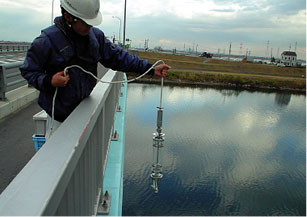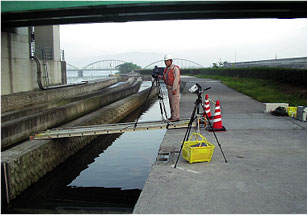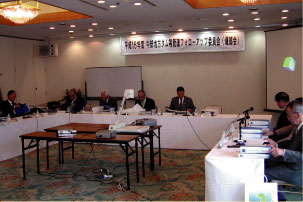Surveys Carried Out After the Barrage Went into Operation
[Nagaragawa Estuary Barrage Monitoring]
With a view to conserving the environment of the Nagara River and ensuring that the Nagaragawa Estuary Barrage achieves its intended purpose, a five-year (1995-2000) survey (monitoring) was conducted to monitor the changing environmental conditions after the barrage went into operation and evaluate the effectiveness of the environmental conservation measures implemented, with the guidance and advice of academic experts. The monitoring included the following:
- Disaster prevention
- Measures against seepage flow into diked areas
- Salinity
- Quality of water and bed material
- Ecology
- Migration of fishes
- Living conditions of plants, animals, fishes and shellfishes

Investigating the quality of water

A survey of Ayu traveling upstream (at the Estuary Barrage)
As a general rule, the survey was conducted openly, with the guidance and advice of the Nagaragawa Estuary Barrage Monitoring Committee consisting of academic experts. The survey results were published in the "Nagaragawa Estuary Barrage Monitoring Yearbook."
The monitoring committee held a total of 12 meetings for deliberations over a period of five years from 1995. Through these deliberations, the committee provided guidance and advice necessary for monitoring planning and barrage operation, including instructions for dissolved oxygen (DO) surveys in the water downstream of the barrage and flushing operations designed for effective water quality improvement, to the Ministry of Construction (now the Ministry of Land, Infrastructure and Transport) and Water Resources Development Public Corporation (now the Incorporated Administrative Agency Japan Water Agency). The monitoring committee was disbanded in March 2000 since the initial purpose of the committee had been accomplished. Before disbanding, the committee made recommendations concerning the direction of monitoring necessary for the time being to continue operating the barrage appropriately.
Since fiscal 2000, monitoring has been carried out according to the recommendations, and deliberations have been carried out by the Barrage Committee newly formed in the Chubu Regional Dam and Estuary Barrage Management Follow-up Committee.
In 2004, ten years after the start of management, monitoring results were compiled in regular reports and presented to the "Barrage Committee" of the Chubu Regional Dam and Estuary Barrage Management Follow-up Committee for deliberations. Deliberations confirmed that the environment was in a stable state without any problems after the start of operation of the estuary barrage.
The "Barrage Committee" was dissolved in 2004. Deliberations have been continued by the Follow-up Committee.
Meetings of committees on the Nagaragawa Estuary Barrage monitoring held in Nagoya City

- Nagaragawa Estuary Barrage Monitoring Committee
: 1995 through 1999 - Barrage Committee of the Chubu Regional Dam and Estuary Barrage Management Follow-up Committee
: 2000 through 2004 - Chubu Regional Dam and Estuary Barrage Management Follow-up Committee
: 2004 and beyond
Chubu Regional Dam and Estuary Barrage Management Follow-up Committee
Sato, Masataka, Professor Emeritus, Nagoya Women's University
Okino, Tokio, Professor, Waseda University
Sakurai, Yoshio, Professor Emeritus, Shinshu University
Tsujimoto, Tetsuro, Professor, Post-graduate course, Nagoya University
Fujita, Yuichiro, Professor, Gifu University
Komada, Noritomo, Professor, Nagoya Women's University
Ishida, Noriko, Assistant Professor, Nagoya Women's University
Okuno, Nobuhiro, Professor, Chukyo University
Sugito, Daisaku, President, Waste Research Foundation
Nakamura, Hiroshi, Professor, Shinshu University
Matsuo, Naoki, Professor, Chubu University